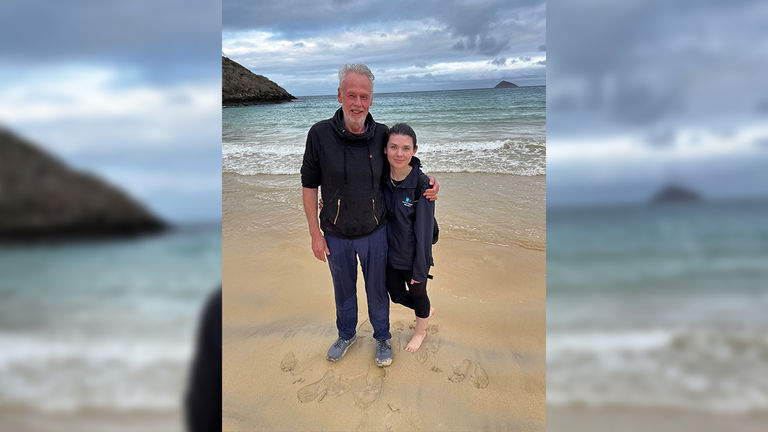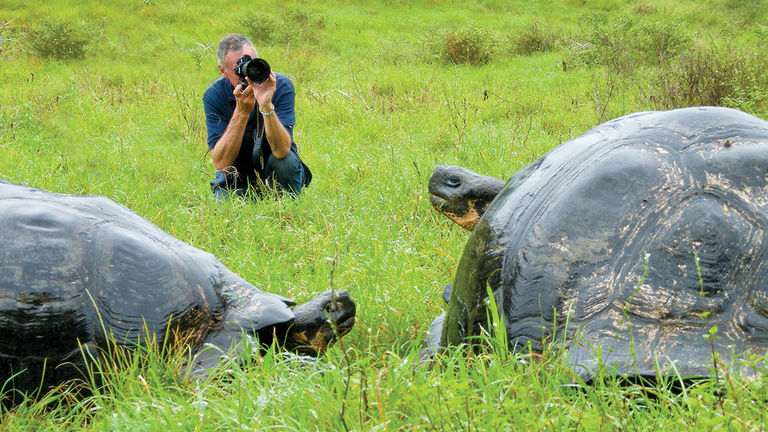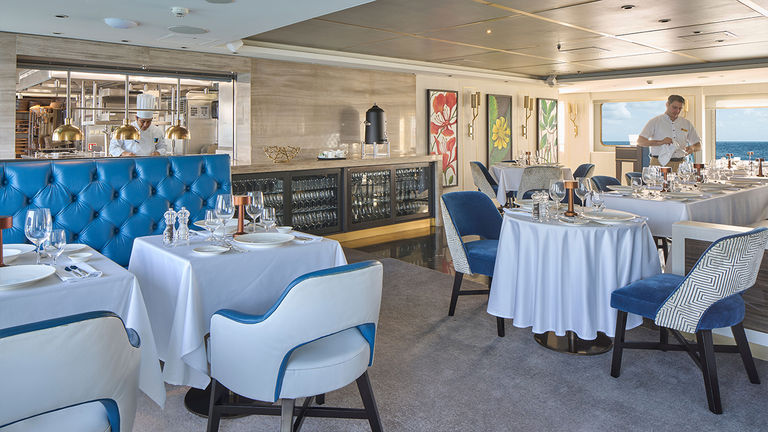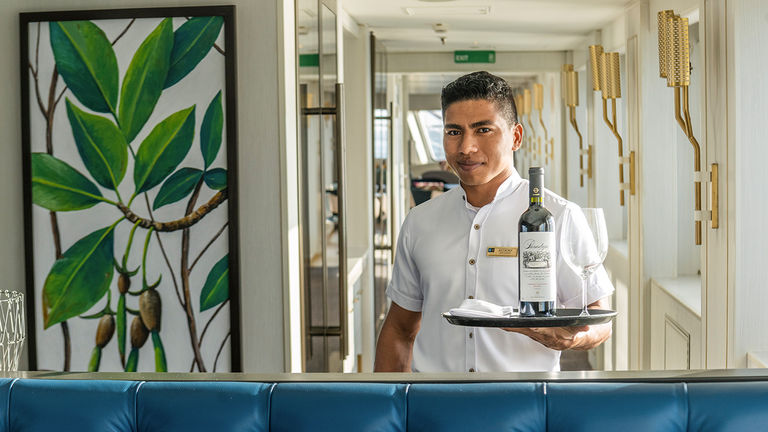Wide-eyed, I watched as Sven-Olof Lindblad, the founder of Lindblad Expeditions – National Geographic waded into the Pacific Ocean — and straight into a fever of Galapagos stingrays.
“Come on in!” he called back to his daughter, Isabella, as he snapped photos from above.
I kept my own feet planted firmly on the white-sand beach of Floreana Island, but was unable to take my eyes off Sven, who was now within spitting distance of the rays’ fluttering wings and giant tails.
The scene perfectly represented the islands’ magic: For even the most adventurous and seasoned explorers among us, they never failed to find new ways to surprise and delight.
Case in point: Sven was just 17 when he first accompanied his father — explorer and adventure travel pioneer Lars-Eric Lindblad — on the first-ever professionally organized trip to the Galapagos in 1967. Since then, he’s been back dozens of times, and began bringing Isabella, who now works for Lindblad’s marketing department, when she was just 2 years old (this visit marked her 18th time to the islands).
 Sven and Isabella Lindlbad
Sven and Isabella Lindlbad
Credit: 2023 Emma WeissmannWhy There's No Place Quite Like the Galapagos Islands
Just hours before, I sat onboard Lindblad Expeditions’ National Geographic Islander II having lunch with the Lindblads and Angela Flaim, godmother of the Islander II — which began sailing in August — and wife of the late Juan Flaim, a Galapagos conservation advocate. Over spoonfuls of Ecuadorian potato soup and bites of fried plantains, Sven reflected on the lack of change he’d seen in the destination over the past 55 years.
“It’s really not particularly different now than it was back then,” he said. “It has been very well-managed by the Galapagos National Park.
“It’s a unique situation: There’s a national partnership with the government, and then with the Charles Darwin Research Station, which is not a government entity, but is sort of the scientific arm of the park. There’s nothing quite like that anywhere else that I’m aware of.”
 The islands have high levels of endemism, meaning that many species found there aren't found anywhere else.
The islands have high levels of endemism, meaning that many species found there aren't found anywhere else.
Credit: 2023 Lindblad Expeditions - National GeographicIndeed, although it’s technically a province of Ecuador, the Galapagos plays by its own set of rules: The government puts a strict cap on visitor arrivals and a laser-sharp focus on natural preservation, which keeps it locked in a time capsule, of sorts. High rates of endemism (many species found here are only in the Galapagos), combined with a lack of human development, leads to serendipitous interactions with wildlife (cue: Sven’s stingray swim).
“When you see animals that are so fearless, and are not afraid of us, you’re able to create a bond with them,” Isabella added.
“They have every right to be afraid of us, and they probably should be, but they’re not. There’s a deeper level of connection.”
They have every right to be afraid of us, and they probably should be, but they’re not. There’s a deeper level of connection.
Onboard the Islander II
Lindblad operates two ships in the Galapagos: The 96-passenger National Geographic Endeavor II, and the 48-guest Islander II.
The Islander II had a former life as the 68-passenger Crystal Esprit (from Crystal Cruises), and underwent a refurbishment before joining Lindblad’s fleet last year.
Former Esprit guests will notice a few obvious changes — four new suites, a boutique, a spa, a Science Hub for visiting researchers and a climate-controlled marina among them — but also hints of the ship’s former, luxurious self: a pair of heated Toto toilets just outside the Yacht Club Restaurant, for example, and marble-wrapped bathrooms in each stateroom.
Although all Lindblad ships are unique from one another, Islander II’s decor leans more into “high-end elegance” than “rugged simplicity.”
But Sven notes that he urges clients to choose ships based on itinerary — not hardware.
“I think people make too much noise about the ship as being primary [to the experience], when they are very much secondary,” he said. “The ship we had here before, the Islander, wasn’t nearly as luxurious as this, but people loved it. At the end of the day, you’re so active: You eat, you sleep, you listen to some [educational] talks, but that’s it. We didn’t look for a ship like this on purpose, but it was an opportunity, and we are very happy with it.”
 Dinners are served in the Yacht Club Restaurant.
Dinners are served in the Yacht Club Restaurant.
Credit: 2023 Lindblad Expeditions - National GeographicPersonally, I loved the ship, but I felt that a bigger selling point was the sense of community onboard. Cruisers were connected via their shared interests in wildlife, photography, science and adventure. An all-Ecuadorian crew and expert Galapagos-based naturalists made a noticeable effort to connect with guests on a personal level. And visiting scientists from the National Geographic Society regaled passengers with tales of their on-location research during nightly lectures.
 Islander II crew is made up of Ecuadorian locals.
Islander II crew is made up of Ecuadorian locals.
Credit: 2023 Lindblad Expeditions - National GeographicA Transformational Experience
But above all, I’ll remember my trip most for the (non-human) connections made with this place and its Earth- and sea-based natives: I snorkeled with spunky sea lions, saw a pair of mating sea turtles from the seat of a double kayak, came eye-to-eye with a Galapagos penguin and stepped over piles of marine iguanas as I hiked across the islands. Although my days often started at dawn, I was always energized.
At lunch, I tried to describe this feeling to the Lindblads. But as repeat explorers to the islands, they already know the effect it has on visitors.
It’s gratifying to be in a business where you create transformative experiences. Where you can literally say that someone came with a certain set of perspectives, and left thinking differently about the world.
“I was able to come around [the islands] at every stage of my life, and it meant something different to me at every point,” Isabella said.
“It’s gratifying to be in a business where you create transformative experiences,” Sven added. “Where you can literally say that someone came with a certain set of perspectives, and left thinking differently about the world.”